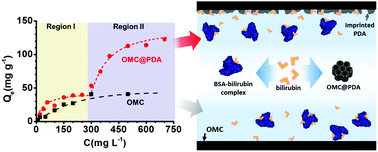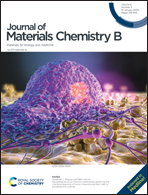Polydopamine decorated ordered mesoporous carbon for efficient removal of bilirubin under albumin-rich conditions†
Abstract
Excess bilirubin in the body will lead to serious health problems; however, its efficient removal remains a challenge in the clinical field because the available sorbent materials still suffer from serious performance issues, performance declining in a high-content albumin environment. Herein, we prepared a novel polydopamine (PDA) decorated ordered mesoporous carbon (OMC) material for the efficient removal of bilirubin in albumin-rich conditions. OMC was used as the supporting material due to its high specific surface area and its good affinity to hydrophobic analytes. PDA was then decorated on the OMC material through a facile self-assembly process to form a surface-imprinted layer. The obtained PDA-coated OMC material (OMC@PDA) exhibited excellent adsorption performance towards bilirubin in albumin-free conditions, in which its theoretical maximum adsorption amount was calculated to be 513.54 mg g−1. The imprinted PDA layer, for which the association constant towards bilirubin reached 4.51 × 104 M−1, endowed OMC@PDA with a competitive affinity compared to albumin. Therefore the materials showed good adsorption capacity and efficiency even in an albumin-rich environment (the adsorption equilibrated at 122.7 mg g−1 in 30 min). In addition, the good biocompatibility of OMC@PDA was demonstrated by hemolysis assay and protein fouling evaluation, which indicated the feasibility of applying this material in clinical situations.



 Please wait while we load your content...
Please wait while we load your content...